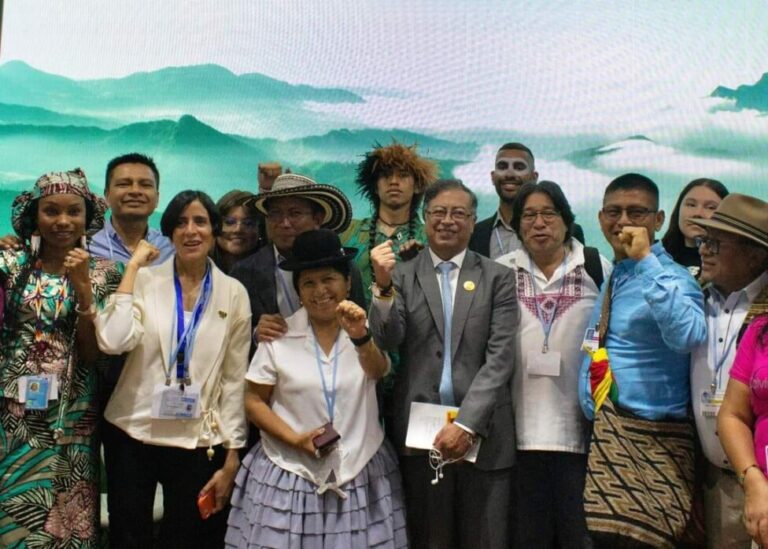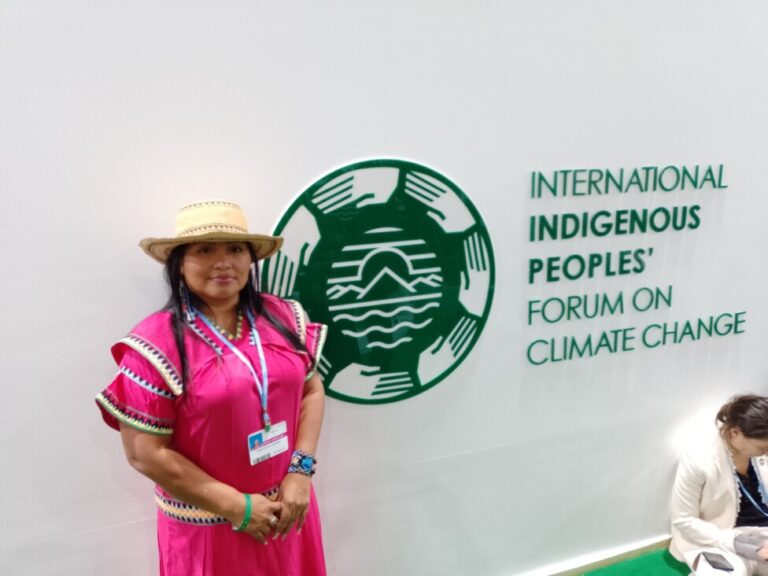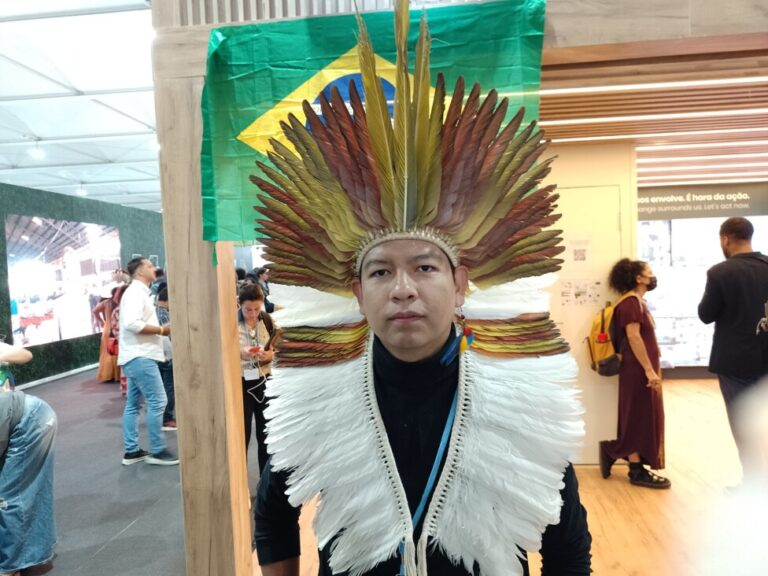Summary:
-
Because of this, at COP26 in Glasgow, Scotland, a year ago, the governments of the United Kingdom, Norway, the United States, Germany, and the Netherlands, and 17 private donors pledged up to $1.7 billion to help indigenous communities take action to reduce climate change and adapt to it.
-
However, it is thought to be between 60 and 80. About 250 indigenous people from all over the world are participating in COP27 in the amount of the Sharm el-Sheikh Convention Center, which is for social organizations and institutions.
-
Still, he says that indigenous peoples must have direct access to environmental and climate funds.
-
Luiz Inácio Lula da Silva, the next president of Brazil, will attend the second week of COP27.
-
They need to be easier to use because they are essential to the fight against climate change.
At the 27th Conference of the Parties (COP27) on Climate Change, indigenous people are no longer happy to watch and be seen as victims of the effects of the current development model. So, they went to the summit in Egypt with their plans, such as the demand that their communities get money directly for climate action.
Each year, governments, private funds, and foundations give billions of dollars in aid to help people adapt to and lessen the effects of climate change. Donors often look for indigenous people because they are now thought to be the best guardians of ecosystems that are good for the climate. But only crumbs make it to the places where people live.
“We are tired of money going to indigenous foundations without indigenous people,” Yanel Venado Giménez told IPS at the stand for indigenous peoples at this vast world conference with 33,000 accredited participants. “All the money is used to pay consultants and keep the offices cool.”
“There are international donors at the COP27. So, we went to tell them that the only way to make sure that climate projects take into account indigenous cultural practises is to give direct funding. We have our own agronomists, engineers, lawyers, and a lot of other people with training. We also know how to work well as a group “she said.
Giménez is a lawyer and a member of the Ngabe-Buglé people. She works for CONAPIP, the National Coordinating Body of Indigenous Peoples in Panama.
Indigenous peoples are on the front lines of the fight against the global environmental crisis because they live in many of the best-preserved areas of the world. This is not up for debate.
Because of this, at COP26 in Glasgow, Scotland, a year ago, the governments of the United Kingdom, Norway, the United States, Germany, and the Netherlands, and 17 private donors pledged up to $1.7 billion to help indigenous communities take action to reduce climate change and adapt to it.
But there isn’t any exact information about how much of that total has been given to the communities, but they say they have gotten almost nothing.
“At each of these conferences, we hear big promises of funding, but when we go back to our territories, that agenda is never brought up again,” Julio César López Jamioy, an Inga who lives in the Colombian Amazon rainforest in Putumayo, told IPS.
“In 2021, we were told that we needed to build ways to access and use resources that usually go through governments. We work on this task with allies because of this “he added.

López Jamioy, who is the coordinator of the National Organization of Indigenous Peoples of the Colombian Amazon (OPIAC), thinks it is time to thank many of the non-governmental organizations for the help they have given.
“Up to a certain point, we needed them to work with us, but now it’s time to act through our own organisational structures,” he said.
Latin America being there.
Due to different funding sources, no one knows how many native Latinos live in Sharm el-Sheikh, a seaside resort in the Sinai Peninsula in southern Egypt. However, it is thought to be between 60 and 80.
About 250 indigenous people from all over the world are participating in COP27 in the amount of the Sharm el-Sheikh Convention Center, which is for social organizations and institutions.
From there, they raise their voices and ideas to the halls and stands where the delegates and official negotiators of the 196 parties to the United Nations Framework Convention on Climate Change (UNFCCC), which organizes these annual summits, are meeting.
The indigenous people share a large stand with a few offices and an auditorium with about 40 seats. Here, during the two weeks of COP27, from Nov. 6 to 18, there is a full schedule of events related to the agenda that the indigenous people brought to the climate summit, which has caught the attention of the whole world.

At the start of the Conference, Gustavo Petro, the president of Colombia, met with a group of native people from Latin America. They got his help in their fight against extractive industries in native lands and asked him to talk to other governments on their behalf.
“Most of the time, when governments promise to do something, they don’t follow through. But now we have more allies who help us make a difference and get our plans done, “Jesús Amadeo Martínez of the Lenca people of El Salvador told IPS.
The indigenous representatives came to this Conference as observers, which is another critical point since they want to be part of the negotiations starting at COP28, which will be held in Dubai next year.
Gregorio Daz Mirabal, a representative of the Kurripaco people in Peru’s Coordinating Body for the Indigenous Organizations of the Amazon Basin (COICA), came up with the idea. He told journalists, “We were here before the nation-states. We have the right to be part of the debate because we are not an environmental NGO.”

From being helped to being involved?
Native communities have always been seen as the primary beneficiaries of climate action projects on their land, run by large non-governmental organizations (NGOs) that get the money and give it to the native communities.
But in 2019, the United States Agency for International Development (USAID) released the Policy for Promoting the Rights of Indigenous Peoples (PRO-IP). This policy examines how funding could be used more effectively in native communities.
One problem is that the time it takes to get a project approved is sometimes too fast for indigenous communities to make decisions through consultation. Another problem is that many indigenous communities are not legally registered, so they need an institution to protect them.
Trying out direct financing is still in its early stages. Sara Omi of the Emberá people in Panama told IPS they could get direct funding from the Mesoamerican Fund for Capacity Building of Indigenous Women for communities in Mexico and Central America.
“We focus on sustainable farming, and in the two years we’ve worked, we’ve helped 22 projects, like the recovery of traditional seeds. We don’t have a lot of money, though. “The total cost of all our projects was less than $120,000,” she said.
Omi, a lawyer who went to the private Catholic University of Santa Mara La Antigua in Panama and got a scholarship to study there, said that indigenous people have shown that they are ready to handle aid money.
“Of course, donors need to be held accountable, but the rules must work with the way things are. “Today, only crumbs are getting to native lands,” she said.
Luiz Inácio Lula da Silva, the next president of Brazil, will attend the second week of COP27. This is good news for the people of the Amazon jungle, who have been hurt by the policies and lack of care of outgoing far-right President Jair Bolsonaro regarding environmental and indigenous issues over the past four years.
“Funds that gave money were closed during the Bolsonaro administration,” Eric Terena, an indigenous man who lives in the south of Brazil near the border with Bolivia and Paraguay, told IPS. “They will be brought back to life now, but we don’t want only the government to be able to use them. There is too much red tape in the systems we have now. They need to be easier to use because they are essential to the fight against climate change.
“We see that this COP is more inclusive of indigenous peoples than any of the others,” said Terena, one of the leaders of the Terena people. “But governments need to realise that it’s time for us to get money.”
Analysis by: Advocacy Unified Network

